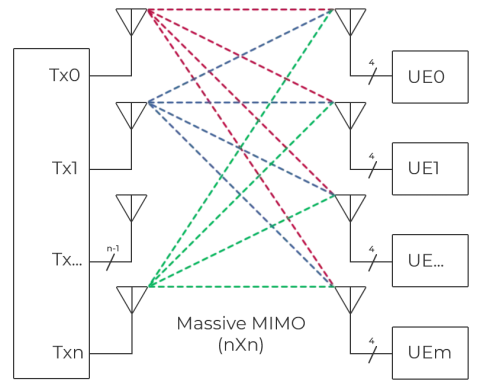
A wireless communication architecture that uses a large number of antennas (often denoted as 'massive' due to the scale, typically in the order of tens or even hundreds) at the transmitter and receiver to facilitate multiple simultaneous data streams. Massive MIMO uses techniques like beamforming, spatial multiplexing, and advanced signal processing algorithms to manage the large array of antennas. These techniques provide highly focused energy transmission, which improves efficiency and mitigates interference. While most commonly observed in base stations to provide MU-MIMO, the technology is capable of being implemented in user devices.

What is Massive MIMO?
Massive MIMO includes a number of multiple antenna configurations including 32T32R, 64T64R, and 128T128R. These systems use a large array of antennas to establish multiple streams of data with multiple devices simultaneously. Massive MIMO uses beamforming technology to construct user dedicated beams which provide increased signal power and reduced interference to multiple users at the same time.
In an nTmR array, there are n transmitting antenna elements and m receiving elements, with each UE leveraging the entire array or a subset therein. Compared to a legacy 2x2 MIMO LTE network, Massive MIMO typically provides a 500 to 800% increase in total cell throughput under the same radio conditions. In 2016 University of Bristol researchers achieved an incredible 145.6 bits/s/Hz using a 128T128R array, representing a 45x increase in cell capacity compared to an ordinary 20 MHz LTE carrier.
Massive MIMO uses an Adaptive Antenna System (AAS) which unlike traditional passive antenna systems (including 2x2, 4x4, and others) uses Power Amplifiers (PA) and Low Noise Amplifiers (LNA) to dynamically control the gain and phase of individual antenna elements. This technology allows an AAS to use constructive and destructive interference to form unique radiation patterns in both the elevation and azimuth directions, a key technology behind 3D beamforming.